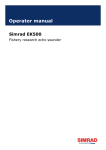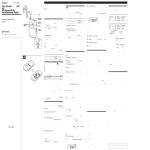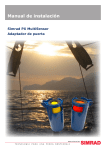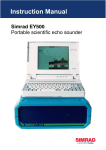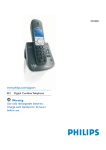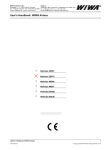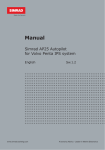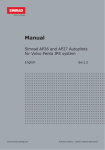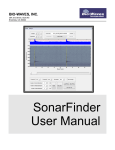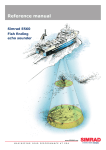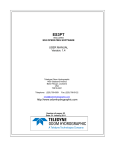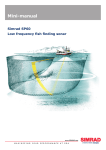Download Kongsberg Simrad EA 500
Transcript
Operator manual Kongsberg Simrad EA 500 Hydrographic echo sounder Base version Kongsberg Simrad EA 500 Hydrographic echo sounder Operator manual - Base version 850--043661 / AA000 / 1--11 Note Kongsberg Simrad AS makes every effort to ensure that the information contained within this document is correct. However, our equipment is continuously being improved and updated, so we cannot assume liability for any errors which may occur. Warning The equipment to which this manual applies must only be used for the purpose for which it was designed. Improper use or maintenance may cause damage to the equipment or injury to personnel. The user must be familiar with the contents of the appropriate manuals before attempting to install, operate or maintain the equipment. Kongsberg Simrad AS disclaims any responsibility for damage or injury caused by improper installation, use or maintenance of the equipment. Copyright E 2001 Kongsberg Simrad AS The information contained within this document remains the sole property of Kongsberg Simrad AS. No part of this document may be copied or reproduced in any form or by any means, and the information contained within is not to be communicated to a third party, without the prior written consent of Kongsberg Simrad AS. KONGSBERG SIMRAD AS Strandpromenaden 50, P.O.Box 111, N-3191 Horten, Norway Telephone +47 33 03 40 00 Telefax +47 33 04 44 24 www.kongsberg-simrad.com Support: hydrographic.support@kongsberg-simrad.com Sales: horten.sales@kongsberg-simrad.com Technical emergency number, outside office hours: +47 99 20 38 01 Operator manual Sections This book is the Operator manual manual for Base version. It describes how to install the various units used by the EA 500 system. The installation of the hull unit is described in a separate manual. 1 System familiarization 2 Operational procedures 3 Command references 4 Maintenance 5 Technical specifications 6 Communication ports 7 Theory of operation 8 Appendices 850-043661 / J I Kongsberg Simrad EA 500 / Base version Remarks References Further information about the EA 500 system may be found in the following manuals: · EA 500 Maintenance manual · EA 500 Installation manual The reader This operator manual is intended to be used by the system operator. He/she should be experienced in the operation of echo sounder systems, or should have attended a Kongsberg Simrad training course. Note This manual includes sections that may be revised individually. In the event of a revision to any part of this manual, this “Cover and Contents” section will be replaced. II 850-043661 / J Operator manual Document logistics Rev Date A 01.06.90 B 01.02.91 C 02.02.91 D 31.08.92 E 25.03.93 F 27.05.93 G 08.09.94 H Written Checked Approved 15.03.96 CL OL EF I 10.06.97 CL EF EF J 21.10.01 RBr ESB GM (The original signatures are recorded in the company’s logistic database.) 850-043661 / J III Kongsberg Simrad EA 500 / Base version Comments Rev Comments A Original edition. Software version 2.40. B Software version 2.60. C New rear panel, changes in section 1 only. D Software version 3.00. E Software version 4.00. The layout of the manual has been updated to confirm with Simrad standards. F Corrections and additions throughout the manual, and in the appendices P2265E Error Messages and P2571E EA 500 DWS. G Correction in section ”Introduction”, page 9. Change notice D227. H Manual modularized, and updated to reflect new software (version 5.20). I Updated to software version 5.30. J Manual digitized. System familiarization and Operational procedures converted to QS with new layout, other documents scanned. No changes to the text. To assist us in making improvements to the product and to this manual, we would welcome comments and constructive criticism. Please send all such - in writing or by e-mail - to: Kongsberg Simrad AS Documentation Department P.O.Box 111 N-3191 Horten Norway or e-mail: simrad.documentation@simrad.com IV 850-043661 / J Operator manual Documents This manual contains the following individual documents: Cover & Contents . . . . . . . . . . . . 850-043551 . Rev.J System familiarization . . . . . . . . . 850-130645 . Rev.B Operational procedures . . . . . . . . 850-130647 . Rev.B Command references . . . . . . . . . . 850-130495 . Rev.B (Software version 5.3) Maintenance . . . . . . . . . . . . . . . . . 850-130682 . Rev.B Technical specifications . . . . . . . . 850-130646 . Rev.A Communication ports . . . . . . . . . . 850-130683 . Rev.A Theory of operation . . . . . . . . . . . 850-130659 . Rev.A Appendices: Status and error messages . . . . . . 859-043870 . Rev.F EA 500 Sample / ping interval . . 859-130088 . Rev.B EA 500 Pinger mode . . . . . . . . . . 859-043976 . Rev.B EA 500 Multi-channel option . . . 859-130096 . Rev.B EA 500 DWS System . . . . . . . . . 859-130177 . Rev.C ASCII - Hex conversion table . . . 859-043869 . Rev.C 850-043661 / J V Kongsberg Simrad EA 500 / Base version Blank page VI 850-043661 / J System familiarization 850-130645 / AA000 / 1-11 EA 500 System familiarization This section of the manual describes the hardware for the echo sounder system. 850-130645 / B I Kongsberg Simrad EA 500 / Base version Document revisions Rev Date Written by Checked by Approved by A 15.03.96 CL OL EF B 19.10.01 RBr ESB GM C D (The original signatures are recorded in the company’s logistic database) II 850-130645 / B System familiarization Table of contents 1 INTRODUCTION . . . . . . . . . . . . . . . . . . . . . . . . . . . . . . . . . . . . . . . . . 1 2 THE SYSTEM UNITS . . . . . . . . . . . . . . . . . . . . . . . . . . . . . . . . . . . . . 2.1 Configuration . . . . . . . . . . . . . . . . . . . . . . . . . . . . . . . . . . . . . . . . . . . . 2.2 Simplified block diagram . . . . . . . . . . . . . . . . . . . . . . . . . . . . . . . . . . . 2.3 Interconnections . . . . . . . . . . . . . . . . . . . . . . . . . . . . . . . . . . . . . . . . . . 2 2 3 4 850-130645 / B III Kongsberg Simrad EA 500 / Base version Document history (The information on this page is for internal use) Rev.A Original issue. Was formerly section 1 of document P2158E. Rev.B Document converted to QS. New images pasted in. No changes to the text. IV 850-130645 / B System familiarization 1 INTRODUCTION Simrad has been in the business of developing special purpose echo sounders since the 1950’s. Accumulated experience, combined with the use of the latest technology and circuit design, has resulted in an echo sounder with greatly improved performance and with a number of unique features. The EA 500 is a modular, triple frequency, high-performance hydrographic echo sounder, with a very accurate reception system and with independent parallel processing within each of the frequency channels. A range of single-beam transducers is available to allow a variety of frequencies to be used. A dedicated 120 kHz split-beam transducer is also available for measuring true seabed inclination in the athwartships direction. A completely new concept is used in the receiver design, providing an instantaneous dynamic range of 160 dB. At the same time, the absolute amplitude measurement accuracy is very high, and this combined with a low self-noise assures optimum operation under most conditions. It should be noted that the receivers are never saturated due to their large instantaneous dynamic range. Hence, very shallow water surveying becomes a trivial exercise. The bottom detection algorithm is implemented solely in software, and separate calculations are performed for each transducer channel. The algorithm is designed with emphasis on reliability, so that erroneous depth detections should not be output. Where uncertainty exists, the algorithm reports unsuccessful detection rather than an unreliable depth value. This feature is considered essential in modern survey work where a post-processor is used for automatic generation of maps, profiles etc. The EA 500 system includes a display and colour printers showing echogram and alphanumeric information. The devices are individually controlled in the sense that echogram range and other presentation parameters are set independently for each device. The sounder is equipped with powerful data interfaces for connection to external postprocessing and data logging systems. 850-130645 / B 1 Kongsberg Simrad EA 500 / Base version 2 THE SYSTEM UNITS 2.1 Configuration The EA 500 hydrographic echo sounder can be configured for single, double or triple frequency operation. The various components included in a triple frequency delivery are shown in Figure 1. These are: · Sounder unit · Display unit (11” LCD, 14” or 20” CRT) · Transducer(s) · Colour printer(s) · RD display RD DEPTH DISPLAY SOUNDER UNIT SIMRAD PRINTER 1 SIMRAD RD LCD DISPLAY HYDROGRAPHIC ECHO SOUNDER PRINTER 2 PRINTER 3 TRANSDUCERS CRT DISPLAY (CD3016) Figure 1 EA 500 system modules A separate transducer is used for each channel, and the operating frequencies available are in the range 12 to 710 kHz. Single-beam transducers are available for all frequencies, and a split-beam transducer is available at 120 kHz for measurement of bottom slope. The sounder is typically connected to an 11” LCD display unit or a 14” colour CRT display unit, both with a built-in joystick. An optional display type is a 20” rack/console-mounted colour CRT unit with a small table-mounted keypad unit. 2 850-130645 / B System familiarization The printers output individually-controllable colour echograms and alphanumeric data. The paper width is 210 mm, with 720-dot resolution across the paper. Transmitter, receiver, processing and power electronics are all housed in the sounder unit; a rugged and compact unit with mechanical dimensions compliant to the 19” rack standard. 2.2 Simplified block diagram Figure 2 shows the simplified block diagram of the echo sounder electronics. TD1 TRANSCEIVER DIGITIZER SIGNAL PROCESSOR INTERFACE TD2 TRANSCEIVER DIGITIZER SIGNAL PROCESSOR CONTROL PROCESSOR TD3 TRANSCEIVER DIGITIZER SIGNAL PROCESSOR DISPLAY/ ETHERNET SERIAL PARALLEL AUX RGB ETHERNET (CD445) Figure 2 Simplified block diagram Each transducer channel comprises the following functional modules: · A transceiver module containing transmitter and receivers · A digitizer module performing A/D-conversion and measurement of electrical phase (applies to split-beam operation only) · A dedicated signal processor implementing algorithms for bottom detection, parameter estimation, echogram generation etc. · A control processor. The signal processor(s) communicates via a common multi-processor bus with the central control processor. This processor coordinates and synchronizes all activities inside the sounder and handles communications with external devices. 850-130645 / B 3 Kongsberg Simrad EA 500 / Base version · A display/Ethernet module controlled by the control processor; the ”Display” part generates standard RGB (Red Green Blue) video signals, and the ”Ethernet” part contains a LAN interface of the Ethernet type. · An interface module including RS232 serial interfaces, Centronics printer interfaces, analogue input signals and output signal for external transmit synchronization. 2.3 Interconnections Figure 3 shows the rear panel of the sounder unit. There are five serial ports of type RS 232: · Serial port 1 - Remote control and data output. · Serial port 2 - Annotation input. · Serial port 3 - Navigation data input/NMEA data output. · Serial port 4 - Sound velocity probe input. · Serial port 5 - Simrad RD remote display output. (CD038 / GIF) FUSE SERIAL PORT 1 CENTRONICS 2 CENTRONICS 4 FIFO SAMPLE DATA FUSE SERIAL PORT 2 CENTRONICS 1 CENTRONICS 3 ETHERNET RGB SERIAL PORT 3 REMOTE CONTROL SERIAL PORT 4 AUXILIARY SERIAL PORT 5 TRANSDUCER 1 TRANSDUCER 2 TRANSDUCER 3 All D-connectors are female, except "Ethernet" Figure 3 Sounder Unit rear connection panel Printers 1 to 3 are connected to CENTRONICS ports 1 - 3, and the display/joystick/keypad units are connected to the RGB and the REMOTE CONTROL connectors. Centronics port 4 is used for transducer sequence operation. The REMOTE CONTROL connector comprises parallel lines for cursor control and numeric input. The AUXILIARY connector includes a differential analogue input for heave/roll/pitch sensor signals and external transmission synchronization input/output signals. 4 850-130645 / B Operational procedures 850-130647 / AA000 / 1-11 EA 500 Operational procedures This section of the manual describes the man-machine interface, gives procedures for switching the system on and off, and includes various operational procedures 850-130647 / B I Kongsberg Simrad EA 500 / Base version Document revisions Rev Date Written by Checked by Approved by A 15.03.96 CL OL EF B 19.10.01 RBr ESB GM C D (The original signatures are recorded in the company’s logistic database) II 850-130647 / B Operational procedures Table of contents 1 INTRODUCTION . . . . . . . . . . . . . . . . . . . . . . . . . . . . . . . . . . . . . . . . . 1.1 Overview . . . . . . . . . . . . . . . . . . . . . . . . . . . . . . . . . . . . . . . . . . . . . . . . 1.2 The joystick . . . . . . . . . . . . . . . . . . . . . . . . . . . . . . . . . . . . . . . . . . . . . . 1 1 1 2 THE DISPLAY AND PRINTER LAYOUT . . . . . . . . . . . . . . . . . . 2.1 The display layout . . . . . . . . . . . . . . . . . . . . . . . . . . . . . . . . . . . . . . . . . 2.2 The printer layout . . . . . . . . . . . . . . . . . . . . . . . . . . . . . . . . . . . . . . . . . 2 2 2 3 COLOUR SCALE . . . . . . . . . . . . . . . . . . . . . . . . . . . . . . . . . . . . . . . . . . 6 4 HOW TO SWITCH THE ECHO SOUNDER ON AND OFF . . 7 5 HARD RESET . . . . . . . . . . . . . . . . . . . . . . . . . . . . . . . . . . . . . . . . . . . . . 8 6 OPERATIONAL PROCEDURES . . . . . . . . . . . . . . . . . . . . . . . . . . . 6.1 Introduction . . . . . . . . . . . . . . . . . . . . . . . . . . . . . . . . . . . . . . . . . . . . . . 6.2 How to start the sounder . . . . . . . . . . . . . . . . . . . . . . . . . . . . . . . . . . . . 6.3 How to generate a bottom range echogram on the display and printer echograms . . . . . . . . . . . . . . . . . . . . . . . . . . 6.4 How to generate scale lines on the display and printer echograms . . . 6.5 How to generate event markers on the display and printer echograms 6.6 How to generate bottom detection line(s) on the display and printer echograms . . . . . . . . . . . . . . . . . . . . . . . . . . . . . . . . . . . . . . 6.7 How to generate annotations on the printer . . . . . . . . . . . . . . . . . . . . . 6.8 How to generate navigation data on the printer . . . . . . . . . . . . . . . . . . 6.9 How to generate an athwartships bottom slope line on the display and printer echograms . . . . . . . . . . . . . . . . . . . . . . 9 9 9 850-130647 / B 9 10 10 10 11 11 11 III Kongsberg Simrad EA 500 / Base version Document history (The information on this page is for internal use) Rev.A Original issue. Rev.B Document converted to QS, images scanned and pasted in. No changes to the text. IV 850-130647 / B Operational procedures 1 INTRODUCTION 1.1 Overview The display unit normally fitted with the EA 500 echo sounder is a 14” colour display. This unit has a joystick located towards the right side of the front panel, below the display, that is used to control the echo sounder system. Other types of display units may use ”Arrow” keys in place of a joystick. Pushing an arrow key will have the same effect as pressing the joystick in the corresponding direction. 1.2 The joystick The joystick enables the operator to move a cursor (a reverse video field) over the desired choices in the menu. Each press up ( ) or down ( ) on the joystick will move the cursor one line up or down in the text. A push to the right ( ) will select the particular parameter, or enter the set value, and return the system to the submenu. Pushing to the left ( ) will exit the parameter or submenu without effecting any changes to the values. A summary of the commands are: Up - Moves the cursor upwards on the menu or increases value of parameter Down - Moves the cursor downwards on the menu or decreases value of parameter Right - Selects parameter/enters value, and returns system to submenu Left - Exits parameter/submenu without making changes, and returns system to previous menu level. 850-130647 / B 1 Kongsberg Simrad EA 500 / Base version 2 THE DISPLAY AND PRINTER LAYOUT 2.1 The display layout The display screen is divided into two main sections; the system menu is displayed towards the left side, and the graphic field (echogram) is displayed towards the right. The following information will be added to the echogram if the appropriate settings are made in the menu by the operator: · Bottom range echogram. · Scale lines. · Bottom slope line. · Bottom detection lines. · Event marker. Figure 1 Display echogram example 2.2 The printer layout The printer is able to generate a combination of echograms, lines and text. Most elements are controlled by parameters located in the Printer Menu. The printer echogram may contain all the information of the display echogram, as well as the additional elements: 2 850-130647 / B Operational procedures · Nautical mile marker · Annotation · Date and time · Navigation text The control of one printer device will have no influence on the other EA 500 output devices. The colour printer is specified for a maximum paper speed of 5 lines/sec. It has a graphic resolution of 720 dots, using 12 different colours ranging from blue to red. Black is used mainly on text and separation lines. The printer may have up to three independent echograms. The echogram number is associated with the transceiver number, hence it will be impossible to print two separate echograms from one transceiver on the same printer. A typical layout of a printout is shown in figure 2, while figure 3 shows an echogram with along. slope fixes. 850-130647 / B 3 Kongsberg Simrad EA 500 / Base version Figure 2 Printer echogram 1 - Annotation text 2 - Annotation date and time 3 - Event marker and number 4 - Navigation data 4 5 - Bottom range 6 - Scale lines 7 - Range 8 - Bottom detection range 9 - Bottom slope 850-130647 / B Operational procedures Figure 3 Printout with four along-slope fixes 850-130647 / B 5 Kongsberg Simrad EA 500 / Base version 3 COLOUR SCALE The colour scale is proportional to the strength of the signals, and the echo strength is divided into twelve colour categories. The scale is logarithmic with a 3 dB step between each colour, giving the colour scale a range of 36 dB from the weakest to the strongest echo signal. Display colour Signal strength range Black/white From weak signal to --44 dB Blue 44 to --41 dB --41 to --38 dB --38 to 35 dB --35 to --32 dB --32 to --29 dB --29 to --26 dB --26 to --23 dB --20 to --17 dB --17 to --14 dB --14 to --11 dB Red From --11 dB to very strong signal The colour scale is displayed in the echogram. Note that the above relationship between colours and dB values is only valid when the Colour Gain parameter is set to 0 dB. 6 850-130647 / B Operational procedures 4 HOW TO SWITCH THE ECHO SOUNDER ON AND OFF 850-130647 / B 1 Switch on the mains power to the Sounder Unit. The On/Off switch is located on the front side of the unit. 2 Switch on the mains power to the Display Unit. The On/Off switch is located on the front side of the unit. 3 Switch on the mains power to the printer(s). 4 To switch the echo sounder off, reverse the above procedure. 7 Kongsberg Simrad EA 500 / Base version 5 HARD RESET Hard reset is achieved by pressing the joystick to the left when switching on the power. The contents of the RAM will then be reset, and the sounder will come up with the default settings. Hard reset is also achieved by pressing the switch behind the hole marked HR on the Transceiver Unit front when switching on the power. 8 850-130647 / B Operational procedures 6 OPERATIONAL PROCEDURES 6.1 Introduction The echogram movement across the screen and on the printer is determined by the setting of the Echogram Speed parameter (Display Menu and Printer Menu) and the Ping Interval (Operation Menu). The echogram colour presentation is mainly influenced by Colour Gain and the selected TVG (DISPLAY/Echogram Menu and PRINTER/Echogram Menu). If the Bottom Range Pres. command is enabled, 20% of the main echogram is overwritten by a bottom-referenced echogram. Note that, in the following procedures, # denotes transceiver number and @ printer number. 6.2 How to start the sounder The following procedure is the minimum required to instruct the echo sounder to start pinging, track the bottom and generate an echogram. In this example it is assumed that only transceiver channel 1 is used. 1 Select the Transceiver menu. 2 Select the Transceiver-1 menu and check that Mode is set to Active. 3 Select the Display menu and check that Echogram is set to 1. 4 Select the Bottom detection-1 menu and set Maximum depth to a value at least as deep as the maximum depth to be expected. 5 Select the Operator menu, and set Ping mode to Normal. After a short delay, the sounder will start to ping and an echogram will begin scrolling from right to left on the display. 6.3 How to generate a bottom range echogram on the display and printer echograms 850-130647 / B 1 Select the DISPLAY/Echogram-# PRINTER/Echogram-# Menu). Menu (or the 2 Set the Bot. Range Pres. command to Upper, Bottom or Lower, depending on where you want the Bottom Range to be positioned. 3 Set Bottom Range to the desired range of the bottom echogram. 9 Kongsberg Simrad EA 500 / Base version 4 Set Bottom Range Start to the desired upper start depth of the bottom echogram. The bottom range echogram is independent of the main echogram. It will overwrite 20% of the main echogram. The bottom range echogram is separated from the main echogram with a solid boundary line. The bottom range echogram is blanked out if no bottom detection has been done. If Sub.Bottom Gain is set above 0.0 dB/m, the bottom range presentation will feature an excess gain below the detected bottom. 6.4 6.5 How to generate scale lines on the display and printer echograms 1 Select the DISPLAY/Echogram-# PRINTER-@/Echogram-# Menu). Menu (or the 2 Select Scale Lines and enter the number of equidistant lines you want across the echogram. How to generate event markers on the display and printer echograms 1 Select the Display Menu (or the Printer Menu). 2 Set Event Marker to On. The event input may be caused by an external push button or activated by Event Counter in the Annotation Menu. The event will result in a red vertical line on the screen and on the printout. The echogram printout will also include the current event number and navigation data. 6.6 How to generate bottom detection line(s) on the display and printer echograms The bottom detection line may be introduced for easy marking of the bottom. Each channel has the possibility of displaying the bottom detection line of other channels. 10 1 Select the DISPLAY/Echogram-# PRINTER-@/Echogram-# Menu). Menu (or the 2 Set Bot. Det. Line to any of these combinations: 1, 2, 1&2, 3, 1&3, 2&3, 1&2&3. 3 To select which type of sub-bottom presentation you want, set Presentation to Normal, Wh. Line or Contour. 850-130647 / B Operational procedures 6.7 6.8 How to generate annotations on the printer 1 Select the PRINTER-@/Echogram-# Menu. 2 Set Annotation to On. 3 Annotation messages received will then be printed on the echogram. How to generate navigation data on the printer 1 Select the PRINTER-@/Echogram-# Menu. 2 Set Navigation Interval to the desired value. 3 The Navigation Interval command sets how often the incoming navigation telegrams are to be printed on the echogram. If, for example, the navigation telegrams are coming in every second and the Navigation Interval is set to 60, the navigation data will be printed every minute. No navigation data will appear on the printer when Navigation Interval i set to 0. 6.9 How to generate an athwartships bottom slope line on the display and printer echograms The athwartships bottom slope line can only be generated if a split-beam transducer is used. To see the bottom slope line on the display, select the Bottom Detection Menu. To get a continuous plot of the slope angle on the echogram, select the DISPLAY/Echogram-# Menu (or the PRINTER-@/Echogram-# Menu) and set Bot. Slope Line to On. The bottom slope information will over-print 20% of the echogram. The athwartships slope line (green) is positive when the bottom is shallower on the starboard side. The slope angle value is plotted as dots in a ±60° scale, with positive values above and negative values below the 0° line. 850-130647 / B 11 Kongsberg Simrad EA 500 / Base version Blank page 12 850-130647 / B Maintenance 850-130682 / AA000 / 1-11 EA 500 Maintenance This section of the manual describes the maintenance to be performed by the system operator. 850-130682 / B I Kongsberg Simrad EA 500 / Base version Document revisions Rev Date Written by Checked by Approved by A 15.03.96 CL OL EF B 21.10.01 RBr ESB GM C D (The original signatures are recorded in the company’s logistic database) II 850-130682 / B Maintenance Table of contents 1 INTRODUCTION . . . . . . . . . . . . . . . . . . . . . . . . . . . . . . . . . . . . . . . . . 1 2 PREVENTIVE MAINTENANCE ACTIONS . . . . . . . . . . . . . . . . . 1 850-130682 / B III Kongsberg Simrad EA 500 / Base version Document history (The information on this page is for internal use) Rev.A Rev.B IV First edition as a combined module for EA 500 and EK 500. Was section 5 of P2158E and P2170E. Document transferred to QS, now only valid for EA 500. No changes to the text. 850-130682 / B Maintenance 1 INTRODUCTION This chapter describes the preventive maintenance to be performed by the system operator. For details about corrective maintenance, refer to the EA/EK/ES 500 Service Manual. For information about error messages, refer to appendix ”Status and error Messages”. 2 PREVENTIVE MAINTENANCE ACTIONS The preventive maintenance is very limited. When required, clean the surfaces of the equipment with a soft, lint-free cloth and a mild detergent. Keep the fan filter of the sounder unit free from dust and moisture. For information about preventive maintenance on the printer, refer to the printer instruction manual. 850-130682 / B 1 Kongsberg Simrad EA 500 / Base version Blank page 2 850-130682 / B Simrad EA 500 / EK 500 STATUS AND ERROR MESSAGES P2265E / 859-043870 / 4AA005 This section of the manual details the status and error messages that may be displayed by the echo sounder from time to time. All the possible messages are listed, and an explanation is given for each. P2265E/F 1 Status and error messages Document revisions Rev 2 Documentation department Hardware/Software Design Project/Product Management Date Sign Date Sign Date Sign E 15.03.96 CL 18.03.96 OL 18.03.96 EF F 22.05.97 CL 22.05.97 HS 22.05.97 RLN P2265E/F Simrad EA 500 / EK 500 List of contents 1 INTRODUCTION . . . . . . . . . . . . . . . . . . . . . . . . . . . . . . . . . . . . . . . . . . . 5 2 GENERAL MESSAGES . . . . . . . . . . . . . . . . . . . . . . . . . . . . . . . . . . . . . . 5 3 SIGNAL PROCESSOR (SP) ERROR MESSAGES . . . . . . . . . . . . . . . . . . 3.1 INTRODUCTION . . . . . . . . . . . . . . . . . . . . . . . . . . . . . . . . . . . . . . . 3.2 LIST OF SIGNAL PROCESSOR ERROR MESSAGES . . . . . . . . . . 7 7 8 P2265E/F 3 Status and error messages Document history (The remainder of the information on this page is for Simrad internal use). Revisions: Rev. A Rev. B Rev. C Rev. D Rev. E Rev. F 4 01.02.91 25.06.92 31.08.92 16.06.93 Original edition. Minor changes to text. Document updated, minor changes to text. Document re-formatted to bring it up to Simrad standards. Document re-formatted to bring it up to new Simrad standards. This document now applies for both EA 500 and EK 500 echo sounders. New error message included (Serial receive overload). P2265E/F Simrad EA 500 / EK 500 1 INTRODUCTION The 500-series echo sounders may issue alarms, errors, warnings and other messages to the display and external devices (via serial port or Ethernet). Note that the # sign indicates the number of the transceiver unit affected (1/2/3). No number is issued for echo sounders with only one transceiver. Note that the lists include messages for all the echo sounders in the 500 series. 2 GENERAL MESSAGES All messages starting with "SP-#" concern signal processor no. # (described in chapter 3). Message Explanation Bottom lost alarm # Bottom tracking lost for transceiver-# Display not ready Display overload (may occur if system unable to update display with the current ping rate) External trigger error Expected trigger pulse not received Illegal remote parameter Parameter value of received remote command out of range or not recognized Internal error # * Internal error 7 Spurious interrupt (caused by badly formed trigger pulses etc.) LAN interrupt level fault * LAN invalid ind. address The EA 500 local Ethernet address must be an individual address, i.e. least significant bit of first byte of address must be zero LAN invalid multic. adr. Invalid EA 500 multicast address LAN multicast table full * LAN no command blocks May appear while CPU is heavily loaded. Regular appearance of this message indicates a LAN interface terminator or hardware problem LAN no transmit blocks See above LAN receive overload Too much data received from LAN (Local Area Network), data is lost LAN socket table full * LAN too high priority * LAN too long message * P2265E/F 5 Status and error messages Message Explanation LAN UDP port busy * LAN 82586 init error Unable to initialize 82586 chip. Possible hardware fault. Maximum depth alarm # Bottom of transceiver-# has been detected deeper than the maximum depth alarm setting Minimum depth alarm # Bottom of transceiver-# has been detected shallower than the minimum depth alarm setting Navigation telegram error Invalid navigation telegram received Ping interval warning Ping interval time exceeded Printer-1 not ready Printer-1 not connected, offline or not ready to print yet Printer-2 not ready Printer-2 not connected, offline or not ready to print yet Printer-3 not ready Printer-3 not connected, offline or not ready to print yet Rem. annotation received Remote annotation has been received successfully Remote command ignored Remote control received while remote control disabled Remote parameter entered Remote parameter received, decoded and entered successfully Remote request executed Remote request has been executed successfully Serial Com. load warning Too much data is directed to serial port, data may soon be lost Serial Com. overload Too much data is directed to serial port, data is lost Serial line 1 error Serial port 1 failure Serial line 1B error RD display serial port failure Serial line 2 error Serial port 2 failure Serial line 3 error Serial port 3 error Serial line 4 error Serial port 4 error Serial receive overload Unable to receive more data on serial port. Data is lost Unknown error * Unknown remote command Invalid remote command path/parameter received Unknown transceiver type Transceiver hardware switch not recognized Display processor error Display/graphic processor (80786) malfunction Disk error 0 File not found Replay end of file Replay data not found Replay bad data File create error File open error File write error File close error 6 P2265E/F Simrad EA 500 / EK 500 Message Explanation Disk full External critical alarm External critical alarm received External alarm External alarm received Table 1 * = Internal software problem encountered. If this error code is displayed, the incident should be reported to Simrad. P2265E/F 7 Status and error messages 3 SIGNAL PROCESSOR (SP) ERROR MESSAGES 3.1 INTRODUCTION The signal processor will read the control parameters sent by the control processor before initiating a new ping. The program will then test each parameter against its legal values. If the parameter is found to be illegal, or the value does not agree with the other settings, an error message code is sent to the control processor which will issue the error message. At power-up the signal processors will never start real pinging until all the parameters are granted. However, in order to receive new information from the control processor, it will simulate pinging until no errors occur. If the error message "SP-# not responding error" is shown on the display, the signal processor has not answered within a time-out period. This error is probably caused by one of the following hardware errors: 1 No signal processor PCB present. 2 A new PROM set is not properly inserted in the signal processor (check carefully). 3 The IC used for signalling is defective (U42 = 8255). This may be checked by inserting a new 8255. 4 The FIFO system on the digital interface pcb is not working properly. (If the sounder uses multiple frequencies, try exchanging the digital interface boards). 5 The signal processor is defective (replace the board, if possible). 8 P2265E/F Simrad EA 500 / EK 500 3.2 LIST OF SIGNAL PROCESSOR ERROR MESSAGES Note that the # sign indicates transceiver number (1/2/3) and that all error messages end with "error". Error message Legal values SP-# angle sensi. error 0 to 100 el./mech. SP-# bandwidth error 0 to 1 SP-# beamtype error 0 to 1 SP-# btm. min. level error -80 to 0 dB SP-# btm. max. depth error 0 to 20000 m SP-# btm. min. depth error 0 to 1000 m SP-# damping coeff. error 0 to 300 dB/km SP-# device data error See note I SP-# equ. beam angle error -100 to -1 dB SP-# FIFO input error 0 to 1 SP-# frequency error 104 to 106 Hz SP-# heave conver. error -10 to 10 V/m SP-# layer data error See note III SP-# noise margin error 0 to 40 dB SP-# not responding error See paragraph 3.1 SP-# ping mode error 0 to 3 SP-# pitch conver. error -10 to 10 V/m SP-# product type error 0 to 1 SP-# pulse length error 0.02 to 10 ms SP-# roll conver. error -10 to 10 V/m SP-# sample interval error 0.005 to 0.5 m SP-# sound velocity error 1400 to 1700 m/s Sample tg error 0 to 1 FIFO tg error 0 to 1 SP-# transceiv. mode error 0 to 3 SP-# transceiver HW error SP-# transd. depth error 0 to 1000 m SP-# transd. seq. error SP-# transd. param. error See note II SP-# transd. gain error 1 to 100 dB SP-# transmit power error 0 to 10 kW SP-# TS phasedevia. error 0 to 10 SP-# TS min. level error -100 to 0 dB P2265E/F 9 Status and error messages Error message Legal values SP-# TS min. length error 0 to 10 SP-# TS max. length error 0 to 10 SP-# TS max. comp. error 0 to 6 dB Table 2 Note I SP-# device data error The appropriate error message in Table 2 will be displayed if one or more of the following parameters are outside legal limits: Parameter Legal values Bottom echogram dots 0 to 200. Bottom range 0 to 100 m. Bottom range start -100 to 100 m. Echogram dots 0 to 1000. Range 0 to 10000 m. Range start 0 to 10000 m. Sub-bottom gain 0 to 5 dB/m. TVG 0 to 2. Table 3 10 P2265E/F Simrad EA 500 / EK 500 Note II SP-# transd. parameter error The appropriate error message in Table 2 will be displayed if one or more of the following parameters are outside legal limits: Parameter Legal values Alongship offset angle -20° to 20° mechanical. Athwartships offset angle -20° to 20° mechanical. Three dB bandwidth 0° to 50° mechanical. Table 4 Note III SP-# layer data error The above error message will occur if one or more of the following parameters are outside legal limits: Parameter Legal values Layer margin 0 to 10 Layer start -100 to 20000 Layer stop -100 to 20000 Layer type 0 to 3 No. of sublayers 1 to 50 Table 5 P2265E/F 11 Status and error messages 12 P2265E/F Simrad EA 500 EA 500 SAMPLE / PING INTERVAL P2483E / 859-130088 / 4AA005 This document provides optimum ping intervals for the various frequencies. P2483E/B 1 Sample interval/ping interval Document revisions Rev Documentation department Date Sign Hardware/Software Design Date Sign Project/Product Management Date Sign B 2 P2483E/B Simrad EA 500 List of contents 1 INTRODUCTION . . . . . . . . . . . . . . . . . . . . . . . . . . . . . . . . . . . . . . . . . . . 5 2 10 M RANGE . . . . . . . . . . . . . . . . . . . . . . . . . . . . . . . . . . . . . . . . . . . . . . . 5 3 25 M RANGE . . . . . . . . . . . . . . . . . . . . . . . . . . . . . . . . . . . . . . . . . . . . . . . 6 4 50 M RANGE . . . . . . . . . . . . . . . . . . . . . . . . . . . . . . . . . . . . . . . . . . . . . . . 6 P2483E/B 3 Sample interval/ping interval Document history (The remainder of the information on this page is for Simrad internal use). Revisions: Rev. A 20.06.92 Rev. B 4 First edition. Document updated to Simrad standards. P2483E/B Simrad EA 500 1 INTRODUCTION This document is a guide to enable you to optimize the ping rate (ping interval). In earlier software versions, the sample interval has been fixed and dependent on the frequency. In software versions 3.00 and later, the sample interval has been made such that it can be selected as required. The tables contain data of the ping intervals obtained during practical testing with software version 3.0. The tests were carried out with only one channel active at a time. 2 10 M RANGE Sample interval (m) Ping interval (second) 38kHz 0.20 0.35 0.10 0.20 0.05 0.03 0.02 0.01 0.13 0.10 0.009 200kHz 0.13 0.10 0.009 0.12 710kHz 0.13 0.10 0.009 0.12 0.005 0.20 With 3 cm sample interval and 10 m main range, a sample interval of 0.10 seconds will give 10 pings per second. With 2 cm sample interval and 10 m main range, more than 10 pings per second will be transmitted. P2483E/B 5 Sample interval/ping interval 3 Sample interval (m) Ping interval (second) 0.20 0.10 0.05 0.03 0.02 0.35 0.21 0.13 0.11 0.13 200kHz 0.13 0.11 0.13 0.21 710kHz 0.13 0.10 0.009 0.21 0.38 0.01 0.005 38kHz 4 Sample interval (m) Ping interval (second) 6 25 M RANGE 0.01 50 M RANGE 0.20 0.10 0.05 0.03 0.02 0.35 0.21 0.13 0.15 0.21 200kHz 0.13 0.15 0.21 0.35 710kHz 0.13 0.15 0.20 0.34 38kHz 0.005 0.68 P2483E/B Simrad EA 500 EA 500 PINGER MODE P2372E / 859-043976 / 4AA005 This document describes the 12 kHz listening transducer. P2372E/B 1 Pinger mode Document revisions Rev Documentation department Date 2 A 31.08.92 B 15.03.96 Hardware/Software Design Project/Product Management Sign Date Sign Date Sign CL 18.03.96 OL 18.03.96 EF P2372E/B Simrad EA 500 List of contents 1 INTRODUCTION . . . . . . . . . . . . . . . . . . . . . . . . . . . . . . . . . . . . . . . . . . . 5 2 SPECIFICATIONS . . . . . . . . . . . . . . . . . . . . . . . . . . . . . . . . . . . . . . . . . . 2.1 TRANSDUCER . . . . . . . . . . . . . . . . . . . . . . . . . . . . . . . . . . . . . . . . . 2.2 TRANSCEIVER . . . . . . . . . . . . . . . . . . . . . . . . . . . . . . . . . . . . . . . . . 2.3 RANGE PERFORMANCE (12 KHZ) . . . . . . . . . . . . . . . . . . . . . . . . . 6 6 6 6 3 SYSTEM OPERATION . . . . . . . . . . . . . . . . . . . . . . . . . . . . . . . . . . . . . . . 7 4 TIMING STABILITY . . . . . . . . . . . . . . . . . . . . . . . . . . . . . . . . . . . . . . . . . 8 P2372E/B 3 Pinger mode Document history (The remainder of the information on this page is for Simrad internal use). Revisions: Rev. A 31.08.92 Rev. B 15.03.96 4 Original version. Document updated and brought up to Simrad's standards. P2372E/B Simrad EA 500 1 INTRODUCTION Simrad has developed a 12 kHz transducer for pinger listening. The transducer beam width is approximately 50°, and the beam is circular. One or more of the three channels of the EA 500 can be used for receiving pinger signals. The frequency of the transceiver channel must correspond with the pinger frequency. The EA 500 pinger mode may be used for tracking objects relative to the surface/bottom or relative to each other. Note To avoid damaging the transducer, Simrad strongly recommends that you install a transceiver board specially made to be used in conjunction with the 12 kHz pinger mode transducer. P2372E/B 5 Pinger mode 2 SPECIFICATIONS 2.1 TRANSDUCER Transducer reg. no: . . . . . . . . . . . . . . . . . . . . . . . . . . . . . . . . . . . . . 312-083741 Frequency: . . . . . . . . . . . . . . . . . . . . . . . . . . . . . . . . . . . . . . . . . . . . . . 12.0 kHz Transducer beamwidth: . . . . . . . . . . . . . . . . . . . . . . . . . . Approx. 50° circular Receiver bandwidth: . . . . . . . . . . . . . . . . . . . . . . . . . . . . . . . . . . . . . . . 1.5 kHz 2.2 TRANSCEIVER Transceiver PCB, 12 kHz reg. no. . . . . . . . . . . . . . . . . . . . . . . . . . . 382-074824 2.3 RANGE PERFORMANCE (12 KHZ) Assumed ship noise level: . . . . . . . . . . . . . . . . . . . . . . . 50 dB ref. 1µPA, 1 Hz Assumed signal to noise level: . . . . . . . . . . . . . . . . . . . . . . Better than 10 dB 6 Pinger source level (rel. 1 µPa) (dB) Receive direction (rel. to vertical) (°) Max. range direct signal (m) Max range bottom reflection (m) 193 0 14000 7000 185 0 11000 3500 185 ±50 5000 800 185 > 70 3000 300 P2372E/B Simrad EA 500 3 SYSTEM OPERATION Select the Operation menu and set the Ping interval to a desired value corresponding to the pinger pulse repetition rate. Select the desired Transceiver-# menu(s) and set Mode to Passive. This is a passive listening mode with no transmitter pulses. The echo sounder can be operated with or without TVG (refer to the Display / Echogram-# menu). The parameter Colour gain (see the Display / Echogram-# menu) may be manipulated to obtain echograms that cover the desired signal strength rate. P2372E/B 7 Pinger mode 4 TIMING STABILITY Due to the drift of the two independent clocks, one (the echo sounder and one in the pinger) the displayed pulse from a constant-depth pinger may drift slowly over the echogram. The stability of the clock in the echo sounder is better than 50 ppm, corresponding to a drift on the echogram of 4.5 m/min. A similar contribution can be expected as a result of the clock in the pinger. 8 P2372E/B Kongsberg Simrad EA 500 Operator manual / Base version Kongsberg Simrad EA 500 Operator manual / Base version Kongsberg Simrad EA 500 Operator manual / Base version Kongsberg Simrad EA 500 Operator manual / Base version














































































































































































































